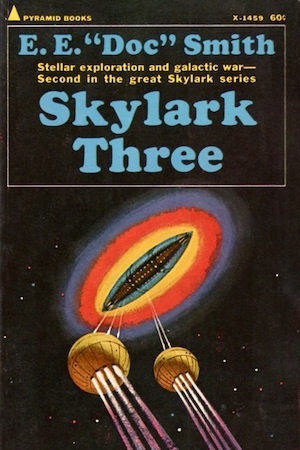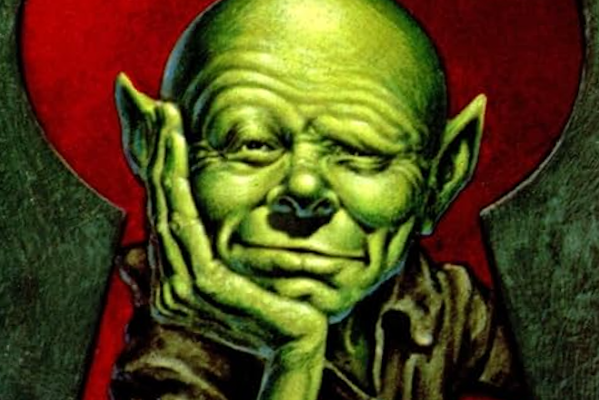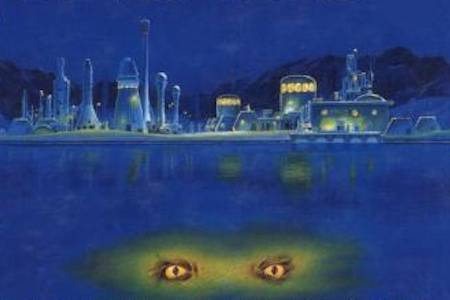In this bi-weekly series reviewing classic science fiction and fantasy books, Alan Brown looks at the front lines and frontiers of the field; books about soldiers and spacers, scientists and engineers, explorers and adventurers. Stories full of what Shakespeare used to refer to as “alarums and excursions”: battles, chases, clashes, and the stuff of excitement.
Today, I’m taking a look at the sequel to E. E. “Doc” Smith’s audacious first novel, Skylark of Space. This next book, Skylark Three, doesn’t rest on the laurels of its predecessor, and expands on those adventures in terms of the scope of the science, the strangeness of the aliens and their worlds, and the brutality of the battles. In fact, it expands on everything to what feels like an exponential degree—if you are looking for restraint and nuance, you will soon realize Smith is not the author for you.
I am embarrassed to admit that while I owned copies of the Skylark series for some time, I didn’t start reading them because I thought I lacked the second book of the series. I had The Skylark of Space, Skylark Three, and Skylark of Valeron. It was only when I read the first book, and started doing some research, that I realized that the second book was already in my hands. In the first book, the original Skylark took the adventurers to the planet Osnome, and when it was damaged, the Osnomians helped them build the Skylark Two to return home. The second book of the series takes its name from another, newer ship dubbed the Skylark Three. Reading through comments on the Internet, it’s clear that I am not the first person confused by the second book having “Three” in the title, nor do I expect to be the last.
Skylark Three, which appeared in Amazing Stories in 1930, is the first sequel to The Skylark of Space, which debuted in Amazing Stories magazine in 1928 (you can see my review here). It was first published in novel form by Fantasy Press in 1948. There were two more sequels after that: Skylark of Valeron, which appeared in Astounding in 1934 and 1935, and the later Skylark DuQuesne, which appeared in Worlds of If in 1965.
The copy of Skylark Three I reviewed is a reissue from Pyramid books, a third paperback edition published in 1966. The cover features a nicely composed impressionistic painting by Jack Gaughan, showing an early scene in the books where the spherical Skylark Two and a similarly shaped Osnomian ally engage with a dirigible-shaped craft piloted by the imperialistic Fenachrone. Gaughan had also illustrated Pyramid’s reprints of Smith’s Lensman series.
I’ve previously reviewed Smith’s entire Lensman series, including Triplanetary, First Lensman, Galactic Patrol, Gray Lensman, Second Stage Lensmen, Children of the Lens, and Masters of the Vortex. Once again, as with the Lensman books, I must thank Julie at Fantasy Zone Comics and Used Books for finding this book for me.
About the Author
Edward Elmer Smith (1890-1965), often referred to as the “Father of Space Opera,” wrote under the pen name E. E. “Doc” Smith. I included a complete biography in my review of Triplanetary. Like many writers from the early 20th century whose copyrights have expired, you can find quite a bit of work by Doc Smith on Project Gutenberg here, including Skylark Three.
Science and Total War
There are two major themes at play in Skylark Three. The first is scientific discovery, and the second is the concept of total war.
I had discussed the scientific element in my review of The Skylark of Space. And some of my favorite sections of the second book are the parts where Dick Seaton is working alongside the Norlaminians, providing the scientists of this advanced race with the raw materials they need to put into practice the theories they have been developing over centuries of research. Smith’s excitement is palpable as he considers what scientists might find beyond the boundaries of what they currently knew and understood. However, my enjoyment of these passages was tempered by thoughts of how Seaton planned to employ that technology. I was reminded of my recent re-read of The Making of the Atomic Bomb by Richard Rhodes (discussed here), and the knowledge that the excitement of scientific discovery and engineering marvels was going to end in the horrors of Hiroshima and Nagasaki.
The idea of war with alien races was a common one in the early days of science fiction. It is not surprising, as the genre was born in an era where wars were being waged with increasing intensity and on a greater scale than ever before. Any idea that man had become too civilized for warfare had died in the mechanized slaughter on the battlefields of Europe during World War I. With new technology like poison gas, high explosives, machine guns, tanks, and aircraft, war had become industrialized, and mass casualties were produced with murderous efficiency. The lines between civilians and enemy combatants began to blur. Humanity had always branded their enemies as less than human, but new theories like Social Darwinism were used by their proponents to argue that such categorizations were “scientific.”
The early days of science fiction were filled with alien races that were more often seen as threats than potential friends. Authors like “Doc” Smith and Edmund Hamilton became known for stories about super weapons that could annihilate entire planets. Their protagonists were often given devices that allowed them to see into the intentions and thoughts of the enemies, as if more perfect knowledge could justify their resort to genocide to end threats to humanity. The most chilling thing about some of these stories was not the measures used by the protagonists; it was how little thought they gave to alternate choices, or peaceful resolutions.
Skylark Three
The book opens in the offices of the industrial conglomerate Steel, Brookings and DuQuesne, a ruthless organization willing to use any means, including assassination, to achieve their goals. “Blackie” DuQuesne is disgusted with his partners’ efforts to kill his rival, Dick Seaton. Not because he doesn’t want Seaton dead, but because he knows his rival is in possession of technology from the planet Osnome, far beyond that available on Earth, and is thus untouchable. DuQuesne is the only other person on the planet with spacefaring technology, and plans to get the upper hand in their struggle by going in search of aliens even more advanced than the Osnomians.
Meanwhile, Dick Seaton, observed by his wife Dorothy, friend Martin Crane, and Martin’s wife Margaret, is testing out a new spacesuit, experimenting with a new force-field generator that creates an impenetrable field, or “zone of force,” around him that actually slices hemispheres of soil from the ground beneath him when he activates it. They are then visited by an Osnomian spaceship, piloted by their friend Donark and his wife Sitar. They have come to Dick for assistance, their world having been attacked by fierce invaders from the planet Urvan, another planet in the Green System at the center of the galaxy. Dick is glad to help, and because of the attempts on their lives, he and Martin decide to leave their businesses in the hands of subordinates and take their wives with them on the journey. They board the Skylark Two and head out to help.
En route, the two ships are attacked by a warship from an aggressive race called the Fenachrone, a warship more powerful than any they have ever encountered. The Osnomian ship is destroyed, and Skylark Two is only saved by Dick’s employment of his new zone of force projector. Dick then uses the zone of force to destroy the enemy vessel, and rescues Donark and Sitar from the wreckage of their ship. Dick has modified the knowledge transfer machine he used to exchange information with the Osnomians so that it can strip information from a being even without consent. He uses it on a Fenachrone prisoner, learning about the race’s imperialistic ambitions, and decides they are irredeemably evil (and both the author and Dick ignore the ethical implications of that mental violation). Dick must find new technology to counter the weapons of the Fenechrone, or all the worlds of the galaxy are at risk. Dick stops briefly to negotiate a truce between the Osnomians and Urvanians, threatening them both with annihilation if they continue their conflict, and providing both with his zone of force technology.
The narrative cuts to Blackie DuQuesne, who is voyaging to find advanced technology to serve his evil ambitions. He has a new henchman, “Baby Doll” Loring, with delicate features of a type often used in pulp fiction to indicate either cowardice or cruelty. Loring serves the author by allowing him to dump all sorts of exposition into “as you know, Bob,” conversations where DuQuesne brings Loring up to speed. They find the wreckage of the Fenachrone warship Dick defeated, and DuQuesne decides to cut a deal with the Fenachrones, heading off toward their homeworld.
Dick travels to the world of the Dasorians, an advance race of aquatic humanoids whose planet is so old the land has entirely eroded into the sea. The Dasorians have many scientific advancements, but refer Dick on to the Norlaminians, an even more advanced race. They are so advanced that they use force beams as tools, and can fabricate a customized laboratory within days. They have been prevented from testing many of their advanced theories due to a lack of resources, which Dick and company are happy to collect for them with the Skylark Two. The Norlaminians have become overly specialized and mechanistic, and are fascinated when Dorothy Seaton performs a violin concert for them, which is about the only time in the book the wives get to do anything other than comfort their husbands (despite his vivid imagination, Smith has trouble imagining women, even those who are green or aquatic, who would not conform to the narrow gender norms of his own era).
The Norlaminians categorize the waves, forces, and particles that humans are aware of as first through fourth level rays, and together they and Dick begin to explore the possibilities of the fifth level. They are pacifists, but after sharing knowledge of the Fenachrone with Dick, are willing to help him develop deadly weapons to employ against them. This part of the book almost sings with excitement, as chemical engineer Smith imagines the perfect laboratory and how it might be used (that excitement being undercut, for this reader, by his plans to use the discoveries and tools he develops for war). They build all sorts of advanced force fields and incorporate their devices into a new, two-mile-long spaceship, the Skylark Three, inside of which the Skylark Two is stored as a small auxiliary vessel. They also develop the means to be telepresent across interstellar distances, travel at incredible velocities, and wield weapons that can destroy entire planets.
Dick and his friends then set out to do battle with the Fenachrone, first with their mighty space navy, and then using the defenses of the planet itself. Despite Smith’s efforts to paint the Fenachrones as ugly, nasty, and evil, I couldn’t help but feel sorry for them. And when Dick and company find a ship full of Fenachrone dissidents (with their wives and children), who are trying to escape to a distant galaxy, they set out in pursuit. After getting quite a bit of attention during the early parts of the tale, DuQuesne’s adventures are ultimately set aside and forgotten. Smith keeps the reader guessing whether the good guys will prevail right up until the end, but as I read, I couldn’t help thinking whether or not I could still consider them the good guys after all they had done.
Final Thoughts
Skylark Three is a sequel that outdoes its predecessor in many ways…perhaps in too many ways. The book throws so many new worlds, new races, and new ideas into the mix that my brain began feeling like a blender as I read. The novel is certainly difficult to read and enjoy if you consider the impacts and consequences of the total war the protagonists are waging. At the same time, it is no wonder Smith stood out from his peers, as there are ideas being tossed off left and right in the book that would influence other writers for decades.
And now is the opportunity for the rest of you to chime in, either on this work in particular, or on “Doc” Smith’s work in general. And as always, if you have any other space opera adventures you want to discuss, the floor is open.














